Beyond the Basics: A Survey of Stereo Microphone Techniques
Surround sound is becoming more ubiquitous than ever, but when it comes to music, stereo is still king. While up to 40% of American households now have surround sound systems, the penetration of stereo is high enough to consider it 100% for all practical purposes—once you take into account all of our computers, headphones, televisions, wireless speakers and hi-fi systems.
Reliable stereo microphone techniques ensure that your work sounds immersive on good headphones and ideal stereo systems, while remaining coherent and powerful in mono, and everywhere else. They also matter when you have more channels to work with: Legendary engineer Frank Filipetti thinks of his GRAMMY-winning surround mixes as a series of adjacent “stereo planes.” And, the principles behind these patterns set the foundation for more complex multi-channel mic arrays.
With that in mind, here are some of the most time-tested stereo mic techniques for delivering power, realism and depth on any system:
XY (and Blumlein Pair)
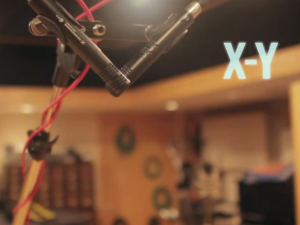
To hear these patterns in action, check out our drum mic video series from this time last year.
XY is probably the fastest and easiest of the conventional stereo mic techniques to pull off. In this setup, you simply point two cardiod microphones at a 90 degree angle from one another, with the capsules as close to touching as possible.
Because the capsules are so close together, the phase coherence and mono compatibility of XY are excellent. The resulting sound should be reasonably balanced and consistent, no matter how unadvisably the end listener may have placed his or her speakers.
This “coincident pair” microphone setup is especially useful when time is short and space is limited. Using a simple stereo bar, it’s easy to get an XY pair going with a single mic stand. (And it would take a lot of talent to mess up the 90 degree placement.)
The sound of XY is tight and coherent, although it lacks some of the immersiveness, realism, depth and stereo spread of some of the more sophisticated stereo techniques.
For a bit more realism and a good sense of space, the “Blumlein” technique is simple modification of the XY array that only requires trading out the cardiod mic patterns for bi-directional. With the flick of a switch or a swap of the mics, the Blumlein version of theis stereo mic array captures a bit more of the reflections of the surrounding environment, adding depth and realism at the cost of a bit of isolation. This variation can be real boon in a great-sounding space, and a real liability in a bad one.
ORTF (and NOS)
Another of the simplest and most foolproof stereo patterns is ORTF, developed in the early 1960s by the French public broadcasting agency, “Office de Radiodiffusion-Télévision Française.” This placement is almost as easy and straightforward as XY, but with a wider spread and greater depth.
In an ORTF pair, it’s the backside of the microphones that are near touching, rather than the front-side. The capsules are spaced about 17cm, or just over 6.5 inches, apart. The angle is slightly wider than that of XY, at 110 degrees. This pattern also works well with a stereo bar, saving on space and mic stands onstage and in tight spaces. (It also looks prettier than XY in my book, if that counts for anything.)
With ORTF, the mono compatibility is still very strong, and the difference between ORTF and XY can be negligible on compromised systems. Heard on a good set of speakers or headphones, however, ORTF turns out to be very little extra work for a subtle but welcome increase in space and realism. This pattern also has the advantage of achieving this extra spread while remaining more directional and less roomy-sounding than a bi-directional Blumlein pair.
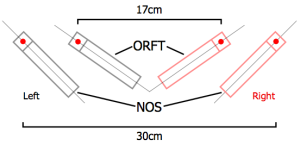 A slight modification of the ORTF array can be found in the NOS technique, developed by the 20th century Dutch public radio agency “Nederlandse Omroep Stichting”.
A slight modification of the ORTF array can be found in the NOS technique, developed by the 20th century Dutch public radio agency “Nederlandse Omroep Stichting”.
Here, the capsules are spaced 30cm (just under 1 foot) apart, at an angle of 90 degrees. It’s a convention that can work better than ORTF at greater distances, and a bit less well when you’re closer in.
Mid-Side (or “MS”)
Finally—an abbreviation that stands for something even us Americans can pronounce. MS or “Mid-Side” is a stereo mic technique that aims to offer the best of both worlds: A super-wide stereo field with perfect mono compatibility. The reality is a bit quirkier than that, but it’s a useful and memorable-sounding pattern that some engineers find addicting.
In the Mid-Side approach, a carioid or omni microphone points directly at the sound source and is panned straight up the center. This mic is then coupled with a bi-directional microphone that points away from the source at a 90 degree angle, so its least-sensitive “null point” is in line with the source. The signal from this bi-directional mic—which picks up mostly the reflections of the room—is then split in two. These duplicate signals are then flipped out of phase and panned hard left and right, giving the impression of a very wide left-right spread.
The effect is quite interesting when hear in stereo: It’s massive and diffuse, focused and wide, all at once. In a way, it’s a bit of a “fake stereo” as the two sides really have the same information, but perfectly out-of-phase. The spread of this pattern can sound “shimmery” “swimmy” and “washy” at the edges, but with a powerful and cohesive center. Due to phase cancellation, this exaggerated stereo aspect completely disappears when the mix is heard in mono, leaving only the center microphone in perfect phase coherence.
In a modern DAW, an MS pair is easy to set up without any specialized tools. Simply record the the “center” mic through one input and the bi-directional “side” mic through another input. You will need to end up with two versions of this “side” mic: one that’s panned left, and another that’s panned right with its polarity reversed. One easy way to do this is by recording the “side” mic onto two channels at once by setting them both to the same input. Then, pan them to different sides and and engage a polarity “invert” plugin on one of the channels. Done! You can hear the extreme width and focus of an MS setup in real time with a minimum of fuss.
(Note: There are other ways to achieve the same effect using aux channels or MS decoder plugins, without having to create a duplicate audio file.)
There are some challenges with this powerful technique: It takes a moment of extra care in adjusting levels during the mix to make sure it balances equally well in mono and stereo. Even with that done, the impression left by the MS elements will be quite different when heard in mono and stereo. Additionally, if it’s used as one part of a multi-mic setup (while recording drums for instance) you may end up with uneven phase cancellation between the left and right sides when you combine these signals. This means that rolling off the lows may be necessary to make it so that your kick drum or similar elements don’t drift to one side of the mix when you blend an MS pair with closer mics.
Although it’s bit more complex to set up the first time out, MS sounds like nothing else. It can feel dramatically wide and almost otherworldly in stereo, but is about at focused as you can get in mono. It may not be as “realistic” as other patterns, but let’s face it: sometimes reality is boring. Say what you will about it, but MS rarely is.
The Decca Tree
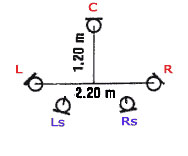
A 5.1 surround variation of the Decca Tree, with left and right surround microphones added to capture sound coming from the rear.
The Decca Tree, developed in the UK in the 1950s, is something of a hybrid setup: It consists of two spaced microphones, often about 6 feet apart, with a center fill mic added in, usually placed about three feet forward from these left/right microphones.
This pattern has been quite popular in classical recording, and has been appearing in live recording rigs and venues in the popular world with increasing frequency. It gives a good overall picture of a space, with good balance, a wide and natural spread, and a strong, clear center as well.
There is no one way to make a Decca tree. I’ve seen them with omnis, which are probably the most traditional, and with cardioid mics, which may be better suited to some spaces and styles. With omnis, the angle of the microphone shouldn’t matter much, but those who favor cardioid tend to angle them outward by 90 degrees or so.
Spaced Pair (or “AB”)
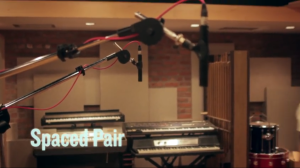
Spaced Pair at Strange Weather Brooklyn. Hear it by clicking here.
You’d think that a simple Spaced Pair of microphones should be easy, but it probably requires more finesse, experience, and trial-and-error to pull off well than any other stereo pattern. It’s also my personal favorite.
The big danger here is with phase cancellation and comb filtering in mono, and with the potential for somewhat unpredictable results when heard on oddly-spaced playback systems. The big benefits are in added space, texture, detail, the room for subtle re-balancing or, artistic exaggeration and in the ability to create a unique and somehow memorable stereo field.
In general, if the spaced pair is too close together and too close to the source, you may experience swimmy-sounding phase issues in stereo, and cancellation and comb-filtering issues in mono. The 3:1 “rule-of-thumb” (which suggests that for every unit of distance you are away from the source, your mics should be three units of distance away from each other) is one decent, although imperfect reference point for this.
Another common recommendation is that spaced pairs be placed 3-10 feet apart, and yet another is that the mics should be far enough apart that the time delay between mics is at least 1.5 ms (this could require as little as 2 feet, depending on distance from the source.) One more decent guideline is that low frequency instruments are usually at their best when centered at a point equidistant between the two mics.
All of these can be helpful frames of reference, but there are simply too many variables to get a truly scientific and objectively “best” distance or ratio. This is one case of many where rules are made to be broken, where we must be satisfied to act on incomplete and ambiguous information, and where we must let our ears and experience be the guide.
Justin Colletti is an audio engineer, educator and journalist.
Please note: When you buy products through links on this page, we may earn an affiliate commission.







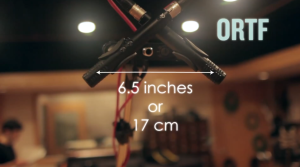
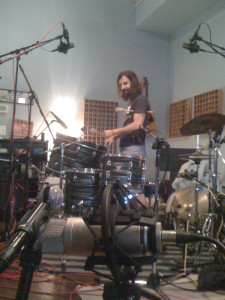
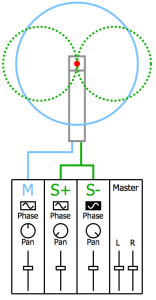
Marc Smith
November 21, 2014 at 10:14 pm (9 years ago)Great piece, Justin. I suppose I should just try it myself but I wonder what are some examples of Mid-side on lead vocal? Is that a thing?
Justin Colletti
November 25, 2014 at 10:41 am (9 years ago)Thanks Marc. I can’t say I can remember any significant instances of mid-side lead vocal recording offhand, but it could be interesting. I know that some folks like to use the technique for background vocals and other small ensemble overdubs.
M-S *processing* can be very useful in working with (or around) vocals at the mastering stage, but that’s a whole ‘nother story. Many mastering De-essers, EQs and compressers may have some kind of M-S processing option built-in, so that you can treat the center content differently than L/R stereo content. But you don’t need to record a vocal using M-S to take advantage of M-S processing at the mastering stage. It’s a similar concept, but another animal entirely.
Hope that makes sense. Maybe good fodder for another article sometime?